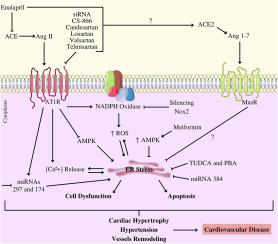Our official English website, www.x-mol.net, welcomes your
feedback! (Note: you will need to create a separate account there.)
Crosstalk between the renin-angiotensin system and the endoplasmic reticulum stress in the cardiovascular system: Lessons learned so far
Life Sciences ( IF 5.2 ) Pub Date : 2021-09-02 , DOI: 10.1016/j.lfs.2021.119919 Vinicius Sepúlveda-Fragoso 1 , Beatriz Alexandre-Santos 1 , Amanda Conceição Pimenta Salles 1 , Ana Beatriz Proença 1 , Ana Paula de Paula Alves 2 , Manuel Vázquez-Carrera 3 , Antonio Claudio Lucas Nóbrega 4 , Eliete Dalla Corte Frantz 5 , D'Angelo Carlo Magliano 2
Life Sciences ( IF 5.2 ) Pub Date : 2021-09-02 , DOI: 10.1016/j.lfs.2021.119919 Vinicius Sepúlveda-Fragoso 1 , Beatriz Alexandre-Santos 1 , Amanda Conceição Pimenta Salles 1 , Ana Beatriz Proença 1 , Ana Paula de Paula Alves 2 , Manuel Vázquez-Carrera 3 , Antonio Claudio Lucas Nóbrega 4 , Eliete Dalla Corte Frantz 5 , D'Angelo Carlo Magliano 2
Affiliation

|
The renin-angiotensin (Ang) system (RAS) is a complex hormonal system present locally in several tissues such as cardiovascular organs. RAS deregulation through overactivation of the classical arm [Ang-converting enzyme (ACE)/Ang-II/Ang type 1 receptor (AT1R)] has been linked to the development of cardiovascular diseases and activation of endoplasmic reticulum (ER) stress pathways. The ER stress is a condition that, if unresolved, might lead to heart failure, atherosclerosis, hypertension, and endothelial dysfunction. Accumulated evidence has shown that the RAS modulates the UPR activation. Several studies reported increased ER stress markers in response to Ang-II treatment, in both and models. Evidence has also pointed that targeting the RAS classical arm through RAS blockers, gene silencing or genetic models leads to lower levels of ER stress markers. Few studies demonstrated protective effects of the counter-regulatory arm (ACE-2/Ang-(1-7)/Mas receptor) over ER stress. However, the crosstalk mechanisms between the arms of the RAS and ER stress remain unclear. In this review, we sought to explore the classical arm of the RAS as a key mechanism in UPR activation and to suggest a possible protective role of the counter-regulatory arm in mitigating ER stress.
中文翻译:

肾素-血管紧张素系统与心血管系统内质网应激之间的串扰:迄今为止的经验教训
肾素-血管紧张素(Ang)系统(RAS)是一种复杂的激素系统,局部存在于心血管器官等多种组织中。通过经典臂 [Ang 转换酶 (ACE)/Ang-II/Ang 1 型受体 (AT1R)] 过度激活而导致的 RAS 失调与心血管疾病的发生和内质网 (ER) 应激通路的激活有关。内质网应激是一种如果不解决可能导致心力衰竭、动脉粥样硬化、高血压和内皮功能障碍的病症。积累的证据表明 RAS 调节 UPR 激活。几项研究报告显示,在 Ang-II 和 Ang-II 治疗模型中,ER 应激标记物有所增加。证据还指出,通过 RAS 阻滞剂、基因沉默或遗传模型靶向 RAS 经典臂,可以降低 ER 应激标记物的水平。很少有研究证明反调节臂(ACE-2/Ang-(1-7)/Mas 受体)对 ER 应激的保护作用。然而,RAS 和 ER 应激臂之间的串扰机制仍不清楚。在这篇综述中,我们试图探索 RAS 的经典臂作为 UPR 激活的关键机制,并提出反调节臂在减轻 ER 应激方面可能发挥的保护作用。
更新日期:2021-09-02
中文翻译:

肾素-血管紧张素系统与心血管系统内质网应激之间的串扰:迄今为止的经验教训
肾素-血管紧张素(Ang)系统(RAS)是一种复杂的激素系统,局部存在于心血管器官等多种组织中。通过经典臂 [Ang 转换酶 (ACE)/Ang-II/Ang 1 型受体 (AT1R)] 过度激活而导致的 RAS 失调与心血管疾病的发生和内质网 (ER) 应激通路的激活有关。内质网应激是一种如果不解决可能导致心力衰竭、动脉粥样硬化、高血压和内皮功能障碍的病症。积累的证据表明 RAS 调节 UPR 激活。几项研究报告显示,在 Ang-II 和 Ang-II 治疗模型中,ER 应激标记物有所增加。证据还指出,通过 RAS 阻滞剂、基因沉默或遗传模型靶向 RAS 经典臂,可以降低 ER 应激标记物的水平。很少有研究证明反调节臂(ACE-2/Ang-(1-7)/Mas 受体)对 ER 应激的保护作用。然而,RAS 和 ER 应激臂之间的串扰机制仍不清楚。在这篇综述中,我们试图探索 RAS 的经典臂作为 UPR 激活的关键机制,并提出反调节臂在减轻 ER 应激方面可能发挥的保护作用。











































 京公网安备 11010802027423号
京公网安备 11010802027423号